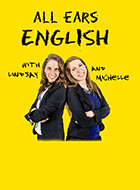Even at the highest levels of business, we can feel nervous when speaking up in a meeting.
Today, our special guest, Anna Connelly, gives us three frameworks for sharing ideas at work.
These are powerful ways to structure what you want to say so that your message is clear.
Anna Connelly with the Confident Business English podcast
Anna has been a guest on several episodes of All Ears English.
She is an accredited neuro-language coach who helps senior managers reach their goals through her weekly podcast, Confident Business English.
Today, she shares tips that will save you time and stress in high-pressure situations.
Many professionals have difficulty expressing their thoughts in business discussions or presentations.
The stakes get even higher when you’re an executive or in a leadership role.
You want to be confident and well-equipped when the discussions require you to speak up and share your opinion.
Listen in and get expert advice on how you can articulate yourself better in meetings.
Preparing for presentations
Lindsay asks Anna to share one thing that senior managers and leaders should be doing more when preparing to present in a meeting.
Anna shares that people forget to use frameworks.
A framework is a way to structure ideas so you can clearly organize what you plan to say.
When you are in high-pressure situations in a second language, a framework will make your life easier.
It will show your colleagues you are prepared and can articulate your thoughts well.
Frameworks
Anna shares three different frameworks today that are practical and useful at work.
If asked to create a presentation for a meeting, being prepared with a framework will up your game.
Anna talks about the frameworks she has picked up along the course of her professional experience.
Many of her clients use these and find them effective.
#1: PRES
This framework is an acronym that stands for Point, Reason, Example, and Summary.
It is great if you need to give your opinion or perspective on something.
This will allow you to get your idea across quickly and clearly.
Here is a scenario to show an example of using this framework:
Scenario: An HR Manager is attending a meeting regarding the rollout of a training program to the entire company
“I’ve taken a look at the company-wide training program and honestly, I think we need to roll it out team by team rather than all at once. From my perspective, this helps us adapt a little bit more and respond to real-time feedback rather than wasting our time and resources if something doesn’t land very well. And actually based on my experience when we launched this last year, we piloted a similar approach with the Marketing team and it enabled us to spot a few mistakes and save a little bit of confusion down the line. So in this case, I would be pretty keen to go for a stage rollout as I think that would give us better data, more control, and a stronger program overall.”
#2: The Three B’s
This is a three-step framework used when you need to persuade or convince someone.
The first “B” is Believe.
In this step, you state your belief or your stance on a certain topic.
The next “B” is Benefit, wherein you let the person know what the benefit is for them or what their key takeaway will be.
In the end, you share your Backup, which is the third “B.”
In this step, you provide evidence to back up your claim.
You can share an experience or data to make your point more solid.
This can be used to get a teammate on board with a decision or convince someone of a good idea.
#3: BLUF
This is another acronym that stands for Bottom Line Up Front.
It originated as a military reporting tactic or practice.
It means that you should say the most important thing, or the “bottom line,” at the beginning.
Once you do that, you can add more context and details after.
This framework is best used when you’re asked to give an update on projects or tasks.
It helps you focus on sharing the most important information first.
You often need to get to the point quickly.
Takeaway
Consider both the culture of your country and workplace when deciding which framework to use.
Choose those that will work best in your work environment.
Once you start using these frameworks often, they will come naturally.
They will help you become more confident in speaking up and clearer with your message.
Learn more from Anna Connelly by listening to her weekly podcast: Confident Business English.
She shares practical tips to combat problems and issues in the workplace so that you can excel in your career.








